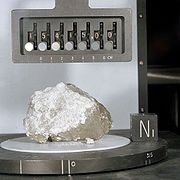
Genesis Rock
Encyclopedia

Apollo 15
Apollo 15 was the ninth manned mission in the American Apollo space program, the fourth to land on the Moon and the eighth successful manned mission. It was the first of what were termed "J missions", long duration stays on the Moon with a greater focus on science than had been possible on previous...
astronaut
Astronaut
An astronaut or cosmonaut is a person trained by a human spaceflight program to command, pilot, or serve as a crew member of a spacecraft....
s James Irwin
James Irwin
James Benson Irwin was an American astronaut and engineer. He served as Lunar Module pilot for Apollo 15, the fourth human lunar landing; he was the eighth person to walk on the Moon.-Early life:...
and David Scott
David Scott
David Randolph Scott is an American engineer, test pilot, retired U.S. Air Force officer, and former NASA astronaut and engineer, who was one of the third group of astronauts selected by NASA in October 1963...
in 1971 during their second lunar EVA.
Chemical analysis of the Genesis Rock indicated it is an anorthosite
Anorthosite
Anorthosite is a phaneritic, intrusive igneous rock characterized by a predominance of plagioclase feldspar , and a minimal mafic component...
, composed mostly of the plagioclase
Plagioclase
Plagioclase is an important series of tectosilicate minerals within the feldspar family. Rather than referring to a particular mineral with a specific chemical composition, plagioclase is a solid solution series, more properly known as the plagioclase feldspar series...
feldspar
Feldspar
Feldspars are a group of rock-forming tectosilicate minerals which make up as much as 60% of the Earth's crust....
, anorthite
Anorthite
Anorthite is the calcium endmember of plagioclase feldspar. Plagioclase is an abundant mineral in the Earth's crust. The formula of pure anorthite is CaAl2Si2O8.-Mineralogy :...
. The rock was formed in the early stages of the solar system
Solar System
The Solar System consists of the Sun and the astronomical objects gravitationally bound in orbit around it, all of which formed from the collapse of a giant molecular cloud approximately 4.6 billion years ago. The vast majority of the system's mass is in the Sun...
, at least 4 billion years ago. It was recovered in a crater of the Moon, near other rocks of its kind.
It was originally thought they had found a piece of the Moon's primordial crust
Geology of the Moon
The geology of the Moon is quite different from that of the Earth...
, but later analysis initially showed that the rock was only 4.1 ± 0.1 billion years old, which is younger than the Moon itself; and was formed after the Moon's crust solidified. But it was still an extremely old sample, and was from the pre-Imbrian era. Probing the rock with electron beams, geologists pegged the rock's age at 4.5 billion years. It therefore may represent a piece of the primordial crust. The solar system was formed only 100 million years earlier.
See also
- Moon rockMoon rockMoon rock describes rock that formed on the Earth's moon. The term is also loosely applied to other lunar materials collected during the course of human exploration of the Moon.The rocks collected from the Moon are measured by radiometric dating techniques...
- Apollo 15 on the MoonApollo 15, Lunar surfaceApollo 15 Commander David Scott and Lunar Module Pilot James Irwin spent three days on the Moon and a total of 18½ hours outside the spacecraft on lunar extra-vehicular activity. The mission was the first not to land in a lunar mare, instead landing at the base of the Apennine Mountains, near...
- Hadley–Apennine (Moon)
- AnorthositeAnorthositeAnorthosite is a phaneritic, intrusive igneous rock characterized by a predominance of plagioclase feldspar , and a minimal mafic component...
External links
- Lunar and Planetary Institute - Apollo 15
- NASA - Apollo 15
- Discovering the Genesis Rock (From the Apollo Lunar Surface Journal, scroll down to 145:41:48.)
- Astronaut Scott examines the Genesis rock. (image)
- An overview of the samples collected by Apollo 15. (The Genesis Rock is sample #15415 and is described but not listed by its number.)

